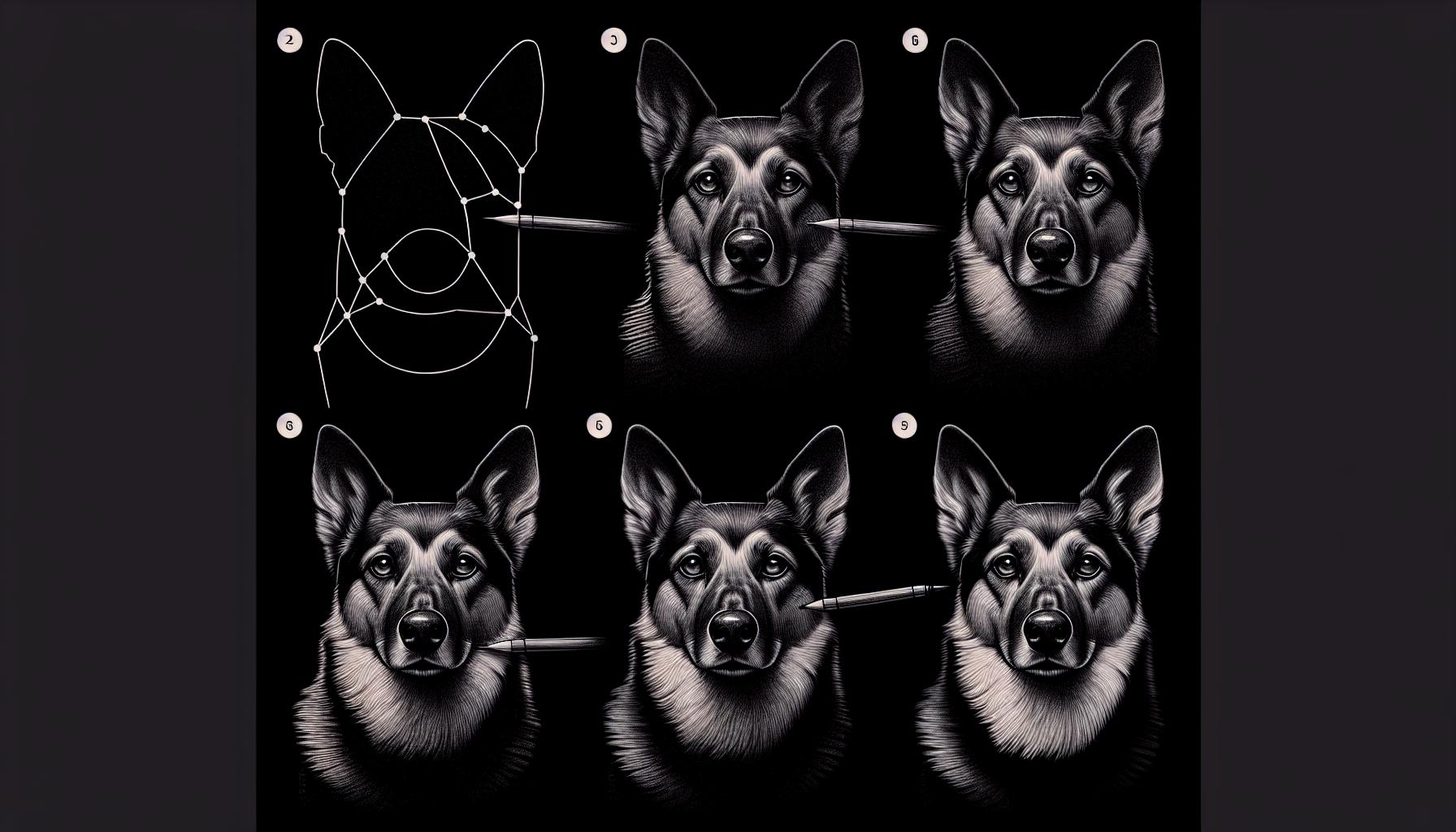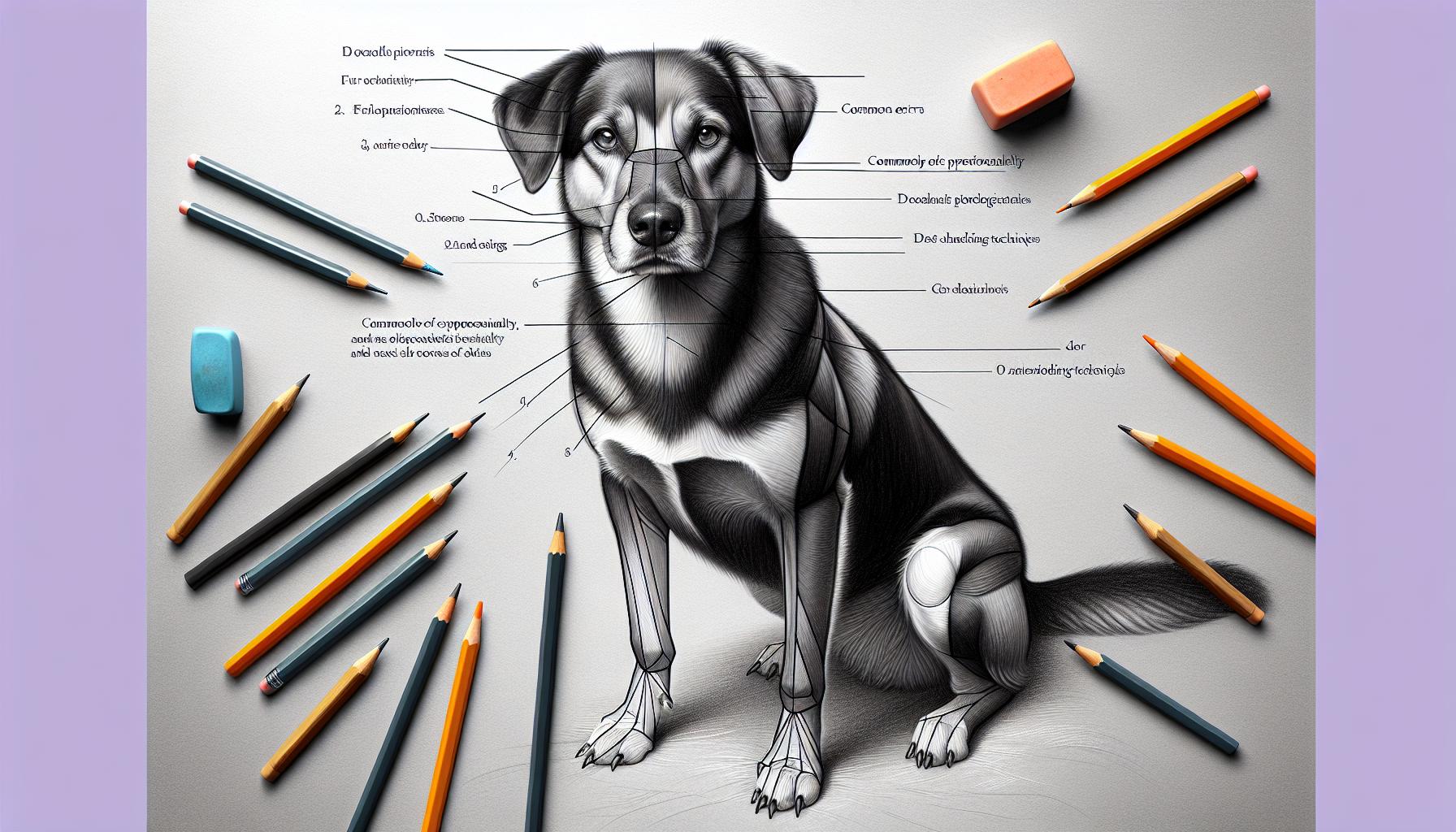Drawing dogs can be a delightful and rewarding experience for artists of all skill levels. Whether you’re a beginner looking to sketch your first furry friend or an experienced artist wanting to refine your technique the simple approach of “facil perro dibujo” (easy dog drawing) offers a perfect starting point.
Learning to draw man’s best friend doesn’t have to be complicated. With basic shapes and straightforward steps anyone can create an adorable canine companion on paper. From playful puppies to dignified adult dogs the principles remain the same – start with simple geometric forms and gradually add the details that bring your drawing to life. Let’s explore how to transform basic circles and lines into a charming four-legged friend that’ll make tails wag with delight.
Facil:73phmyylc2a= Perro Dibujo
Drawing dogs requires a specific set of art supplies for optimal results:
Basic Drawing Tools:
- 2H-6B graphite pencils for sketching outlines
- White polymer eraser for clean corrections
- Kneaded eraser for subtle highlight removal
- Drawing paper (80-100 lb weight) for durability
Enhancement Materials:
- Blending stumps for smooth shading transitions
- Charcoal pencils for deep blacks
- Colored pencils for adding fur tones
- Fine-tip markers (0.1-0.5mm) for details
Surface Options:
- Sketch pad (9×12 inches) for practice
- Bristol board for finished artwork
- Toned paper for dramatic effects
- Textured paper for fur texture
- Drawing board for stable work surface
- Pencil sharpener for precise points
- Artist tape for securing paper
- Reference photos of dog breeds
A standard drawing kit contains:
| Essential Item | Purpose | Recommended Type |
|---|---|---|
| Pencils | Basic sketching | Graphite set (2H-6B) |
| Paper | Drawing surface | 80-100 lb weight |
| Erasers | Corrections | Polymer & kneaded |
| Markers | Detail work | Fine-tip (0.1-0.5mm) |
These materials enable artists to capture both basic shapes and intricate details of dog features. Each tool serves a specific purpose in creating realistic or stylized dog drawings.
Understanding Basic Dog Anatomy

Dog anatomy forms the foundation for creating accurate and appealing dog drawings. Understanding these key anatomical elements enables artists to capture the essence of canine features effectively.
Head and Facial Features
The dog’s head consists of three primary geometric shapes: a circular cranium, rectangular muzzle base, and triangular nose. The eyes sit approximately halfway between the top of the head and bottom of the muzzle, spaced one eye-width apart. A dog’s ears vary by breed, ranging from pointed triangles in German Shepherds to floppy rectangles in Beagles. The snout extends forward from the face in a cylindrical form, ending in a distinctive nose pad. Facial muscles create characteristic expressions through wrinkles around the eyes, forehead, and muzzle areas.
Body Structure and Proportions
The dog’s body follows a balanced 2:3 ratio between height and length from shoulder to tail base. The chest depth reaches approximately to the elbow joint, while the legs comprise about 40% of total body height. The spine curves gently from neck to tail, creating a natural topline. The ribcage forms an oval shape, narrowing at the waist to create the characteristic tucked abdomen. Front legs align straight beneath the shoulders, while rear legs display angular joints at the hock. The neck connects to sloping shoulders at a 45-degree angle, supporting proper head carriage.
Step-by-Step Dog Drawing Guide

Drawing a dog becomes manageable by breaking down the process into simple steps that build upon each other. This systematic approach transforms complex canine features into achievable artistic elements.
Starting With Simple Shapes
Basic geometric shapes form the foundation of a dog drawing. A large circle represents the chest area while a smaller circle creates the head structure. Ovals establish the basic form of the legs front to back. A curved rectangle connects the head to the body forming the neck area. Triangular shapes mark the ears position on the head circle. An elongated oval defines the snout extending from the head circle. These foundational shapes connect to create the initial dog silhouette enabling artists to verify proportions before adding details.
Adding Details and Definition
Fine details transform basic shapes into a realistic dog illustration. The eyes sit approximately halfway up the head circle spaced one eye-width apart. The nose takes a triangular form at the tip of the snout. Short curved lines create fur texture working from the head down to the body. Darker shading adds depth around the eyes ears neck ruff chest area. Light strokes define individual toes on each paw. Varied line weights emphasize the dog’s muscular structure particularly around the shoulders legs. Strategic highlights on the nose eyes create dimension bringing the drawing to life.
Common Mistakes to Avoid

Incorrect proportions disrupt the overall appearance of dog drawings, particularly in the ratio between the head and body. Artists often make eyes too large or position them incorrectly on the face, creating an unnatural look.
Overlooking the skeletal structure leads to anatomically incorrect postures. The spine determines the dog’s natural stance while the ribcage defines the chest’s volume.
Fur texture requires proper direction and flow patterns. Drawing every individual hair creates an unrealistic appearance, instead focusing on clumps and general fur direction produces better results.
Here are specific errors to watch for:
- Drawing legs as straight lines instead of showing joint articulation
- Placing ears at incorrect angles that don’t match the breed’s characteristics
- Creating symmetrical facial features when dogs naturally have slight asymmetry
- Adding whiskers as straight lines rather than curved strands
- Making paws too small or failing to show proper pad structure
Lighting mistakes affect the drawing’s dimension:
- Using uniform shading across the entire body
- Ignoring cast shadows under the belly and chin
- Missing highlight points on the nose and eyes
- Creating hard edges where soft transitions occur
- Failing to show depth in the fur through value changes
These technical errors impact accuracy:
- Pressing too hard with the pencil at the start
- Using erasers incorrectly, causing paper damage
- Smudging intentional lines while shading
- Adding details before establishing basic forms
- Rushing through the initial sketch phase
Reference image dependence creates problems when artists neglect to understand underlying structures. This leads to flat reproductions rather than dynamic drawings that capture the dog’s character.
Tips for Drawing Different Dog Breeds
Different dog breeds display unique characteristics that require specific drawing techniques. Here’s a comprehensive guide for capturing distinct breed features:
Short-Coated Breeds (Beagles, Boxers)
- Draw smooth, continuous lines with minimal texture
- Focus on muscle definition through subtle shading
- Emphasize distinct markings with precise outlines
- Create depth using light cross-hatching techniques
Long-Coated Breeds (Collies, Sheepdogs)
- Layer multiple curved lines to represent flowing fur
- Add volume through varied pencil strokes
- Create texture using irregular line patterns
- Incorporate directional fur movement patterns
Wrinkled Breeds (Bulldogs, Shar-Peis)
- Map out major fold patterns first
- Use curved lines to show skin rolls
- Add shadows in fold creases
- Create dimension through strategic highlighting
Pointed Breeds (German Shepherds, Huskies)
- Define angular facial features
- Draw alert, upright ear positions
- Capture distinctive eye shapes
- Show coat variations through layered shading
- Maintain proportional body ratios
- Draw delicate facial features
- Create fine fur textures
- Emphasize characteristic expressions
| Breed Type | Primary Tools | Secondary Tools |
|---|---|---|
| Short-Coated | 2H-4B Pencils | Blending Stump |
| Long-Coated | 4B-6B Pencils | Kneaded Eraser |
| Wrinkled | 2B-4B Pencils | Tortillon |
| Pointed | HB-4B Pencils | White Gel Pen |
| Small | H-2B Pencils | Fine-tip Marker |
Enhancing Your Dog Drawings
Advanced techniques transform basic dog sketches into lifelike artwork through strategic application of texture shading and fur details. These methods create depth dimension and bring canine illustrations to life.
Adding Texture and Shading
Dog drawings gain realism through varied shading techniques that define form and create visual interest. Artists use crosshatching in darker areas to build shadows gradually with intersecting lines at 45-degree angles. Stippling adds texture through concentrated dots in medium-value areas especially effective for short-coated breeds. Circular strokes create smooth transitions between light and dark regions particularly around the face and muscles. A combination of 4H 2B 6B pencils produces diverse values from light to dark establishing proper contrast. Blending stumps smooth transitions between shaded areas while kneaded erasers lift highlights creating dimensional effects.
Creating Realistic Fur
Fur patterns follow the natural growth direction of a dog’s coat starting at the spine and flowing outward. Short quick strokes with a sharp 2B pencil create individual hair textures in dense areas like the chest ruff. Longer sweeping lines with an HB pencil establish the main fur direction on the body legs and tail. Artists layer multiple strokes from dark to light using 3 different pencil grades to build fur depth. Selective erasing with a precision eraser creates highlights in the fur particularly around the face and ears. Light flicking motions with a fine-tip pencil add whiskers eyebrows and subtle facial fur details.
Drawing dogs can be an accessible and rewarding artistic pursuit for anyone willing to learn the fundamentals. From basic shapes to intricate details every aspiring artist can create charming canine illustrations using the “facil perro dibujo” approach.
Armed with the right tools proper understanding of dog anatomy and attention to breed-specific features artists can bring their furry subjects to life on paper. Whether creating a simple sketch or a detailed portrait these techniques provide a solid foundation for capturing the unique charm and personality of any dog.
Practice and patience remain key to developing strong artistic skills. By avoiding common mistakes and implementing advanced techniques artists will find their dog drawings becoming more lifelike and engaging with each attempt.

